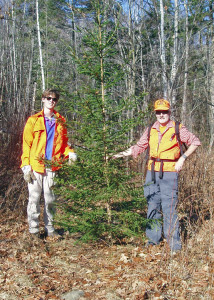
[Editor note: A word of caution before reading this story. If you want to cut your own Christmas tree on the White or Green Mountain National Forest, you need a $5 permit. And most of the offices where you need to buy those permits are closed on weekends. We know . . . it doesn’t make any sense to us, either. . . Plan ahead and call or email to find out how to get a permit.]
Cutting our own Christmas tree has been a on-again, off-again tradition in my household since I was a little bitty kid. Back in the “olden days” it was a family event at my maternal grandparent’s farm. I remember heading out into the woods (there always seemed to be snow in those days, but maybe those are just the times I remember best) with my parents, aunts and uncles and myriad cousins. The kids were all dressed in snowsuits and we scattered like bright confetti in a windstorm to find the perfect balsam fir or spruce.
These weren’t the shaped and manicured trees you find at a cut-your-own Christmas Tree farm or for sale in a parking lot. The only pruning and shaping these trees had was from deer nipping at their twigs and windstorms breaking branches.
But the ones we selected were always beautiful when we put them up in the house and decorated them. Maybe that’s where I first learned that “beautiful” and “perfect” are completely unrelated concepts. Not a bad lesson for a kid to learn . . .
The family farm is long gone; my family has scattered and since those long-ago days; my life has gone through periods of Farmed Christmas Trees, one short-lived experiment with an artificial Christmas Tree, and periods of no Christmas Tree at all (Bah, Humbug!). When we had places to do it legally, we’d search the woods for a wild tree. Those were the best of all.
I recently received a press release from the White Mountain National Forest in New Hampshire telling about their “National Forest Christmas Tree Program.” The Green Mountain National Forest in Vermont has essentially the same program.
You buy a $5 permit at one of the National Forest Offices in Campton, Lincoln, Gorham or Conway NH, or Manchester, Middlebury, Rochester or Rutland, Vermont, and get the right to roam at will over most of National Forest to find any Christmas tree that pleases your eye. You aren’t allowed to cut a trees in or near campgrounds, picnic areas, Experimental Forests, Wilderness Areas, timber sale areas, within 100-feet of a state highway or immediately along roads, streams, hiking trails, or property boundaries. But that still leaves thousands of acres of land to explore and hundreds of thousands of trees to choose among.
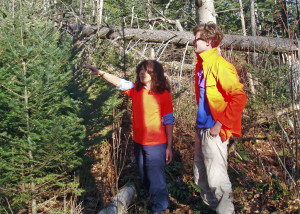
The other rules are pretty simple: make sure you are on National Forest land. Christmas Trees are for personal use only, not for resale. Each family may cut one tree per $5 permit. You must use a hand saw or axe (no chainsaws permitted). No cutting trees larger than 8-inches in diameter at chest high. Cut your tree so the remaining stump is less than 10 inches tall, scatter limbs and pack down limb piles. Easy enough.
There are a couple of things you’ll need to keep in mind for a successful Christmas Tree hunt. First of all, dress appropriately in warm clothing, carry an emergency kit with you and a map and compass. You don’t want to end up lost, and you can’t cut trees along roads and hiking trails.
Second, if you don’t know your trees carry a tree guide with you. Hemlocks look like they’d make great Christmas trees, but the needles start falling off as soon as you cut them. Search until you find a spruce or balsam fir (which smells wonderful).
I guarantee you if you take your family out for a day in the Forest, hike around and find a Christmas tree, it’ll make the most beautiful wild Christmas Tree you’ve ever had.
A Wild Christmas Tree Hunt To Remember
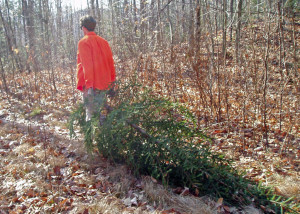
Last Sunday, Marilyn, my son Justin and I headed north to hunt the wily Christmas tree. We got up early, dressed in blaze orange because deer and bear season was still on, and pulled into the new Forest Headquarters building in Campton, NH, just as they opened to get our permit (which is attached to the tree trunk after you’ve cut it—eerily like a hunter tagging a deer.)
We soon found ourselves on a dirt road that traverses forest land and slowly drove along it looking for a likely spot to park and go exploring. An old logging road, long disused, blocked off with large stones, looked promising so we parked and started roaming. A half-mile later, in a spot where gravel had been taken out of a south-facing bank to build the road, we found a cluster of two dozen black spruce and balsam fir trees all about the right height. Because they were growing in a little opening they were more uniformly shaped and a little bushier than typical forest trees.
Still, we wanted to keep looking—it was fun walking on a gorgeous sunny day—so we walked another couple of miles up, up and more up the old logging road, diverting into the woods whenever we saw a stand of evergreens. We found another clump of likely candidates where a huge old spruce tree had fallen, creating another opening in the forest. But none were better than those in that first spot. So we backtracked, and argued a bit over which tree was best. I wanted a balsam but got outvoted by the majority who favored a nearby taller, shapely spruce.
It took only a minute or two to cut it with a sharp Sven Saw, another few minutes to cut off the lower branches with a Gerber Sport Axe
and scatter the branches as directed. Then we carried it to the car, lashed it on the roof and drove home with our trophy proudly displayed.
I think we’ve started a new tradition . . .
Wild Christmas Tree and Managed Forests
I suppose there’s someone out there who will object to the notion of cutting a wild tree for the temporary pleasure of displaying it in our home at Christmas.
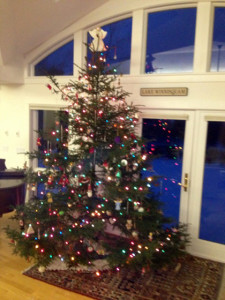
Reality check: The National Forests of the east are, with the exception of designated Wilderness Areas (which are closed to all cutting), carefully managed for multiple use, including timber harvest and recreation. This is a working forest, not a museum.
The tree we cut was growing very close to several other trees of similar size. In harsh reality, they were competing for sunlight and scarce nutrients and not all would survive. By removing one tree, we gave its neighbors space and food to grow bigger and stronger. Regular thinning is part of good forest management.
Feel free to argue with me if you must, but I feel no guilt at all about taking one tree that nature will soon replace.


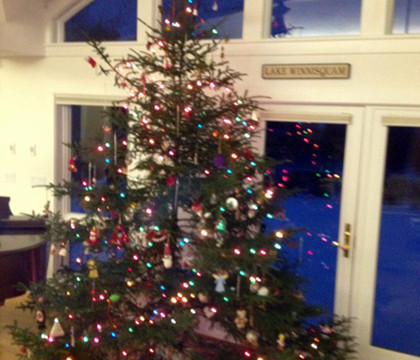
Nice article. Very informative, particularly about why it is OK to cut these trees.
These make the VERY best trees — lightweight, open and airy (great for ornaments!) and so much easier to handle. For several years a tree stand near us in CT would bring in “wild” trees cut from someone’s woodland in Maine. I could get a 12-14 foot tree (great for my cathedral ceiling family room) and I could carry it myself! A balsam fir with a slim trunk, open branch form, old-fashioned “country” look. BUT… the place can’t get them any more. Does ANYONE know a place in Connecticut where you can cut (or even just BUY) “wild” trees like the ones described in this article?? I would LOVE to know about any such place!
Martha,
I know exactly the right place! We are all about getting outdoors and having fun. And buying a pre-cut Christmas Tree (no matter where it came from) probably doesn’t count . . .There are hundreds of thousands of perfect wild Christmas trees available for you to choose from on the Green and White Mountain National Forests in Vermont and New Hampshire. Why not make an adventure of getting your own? Make a reservation at a cozy inn or B&B, enjoy some “authentic” Christmas shopping in a real New England village and and a fine dinner at a restaurant featuring local food. Stop by any of the National Forest offices during regular business hours (or write ahead) and get a $5 permit, take a saw with you, wear your hiking boots and carry a backpack with a lunch, dress warm and go out and find a tree you’ll never forget.
“Life isn’t a spectator sport. Get out and enjoy!”
We were able to get a permit on Sunday, Nov. 18 at the Forest Service desk in the information building just off I-93 , Exit 32 in Lincoln, NH. That is open on the weekends. The permits are also available at the offices in Campton, Gorham and Conway. We hiked Mt. Hedgehog off the Kancamagus Highway-Great views for not too much work. On the way home, we hiked into East Pond from the Tripoli Road and found this red spruce on the way out. We carried it about a mile to the road so it was good exercise.